
The Glass Outdoor Room by Samson
Living with a Glass Room | Shapes and Sizes | Bases and Groundworks | Control the Light and Heat
Control the Rain and Air Flow | Colours | Planning Permission | Glass Specifications | Flooring | The Finer Points of Finishing
What exactly is a glass outdoor room?
Why do I need one? How will one benefit me?
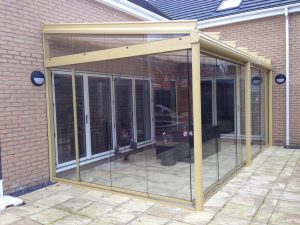 To a newcomer, at first glance glass garden rooms may slightly resemble a better looking conservatory, but they are actually very different in all aspects.
To a newcomer, at first glance glass garden rooms may slightly resemble a better looking conservatory, but they are actually very different in all aspects.
Maybe you enjoy being outdoors as much as possible all year round, and have fantastic views in your garden, or you simply love sitting watching the rainfall. Perhaps you just want a solution to protect you, your family, and your friends when entertaining outside. In these cases, a glass room may well be the answer. It connect the inside with the outside and gives a great space to use most of the year round where a normal conservatory is too hot in the summer and too cold in the winter..
Imagine during those warmer summer months, you have an afternoon party or barbecue organised with your friends and family, and as everyone begins to arrive the clouds roll in and a cooler wind picks up. The outside temperature is still lovely, but it begins to gently rain.
What can you do?
Most retractable awnings, particularly larger sized ones, should not really be used in heavy rain, and especially not if it is windy. A glass room, constructed from aluminium and frameless glass doors will always ensure you have an area outside, with total control over the temperature and air flow by opening or closing the doors on all sides. When all the doors are open the glass room becomes a glass roof canopy, protecting from the heaviest of rainfall at all times. The built in rainwater guttering on the front profile also ensures the rain does not simply flow off the front. It is captured and directed down one or more of the support posts, taken away as required. Glass rooms can be as small or as big as you require.
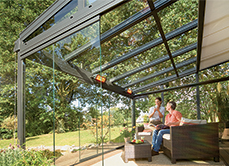
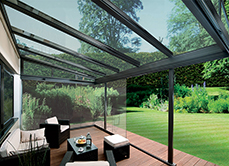
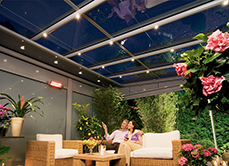
The design and construction of our glass garden rooms are entirely from aluminium, stainless steel, and glass, with beautiful curved profiles, perfectly finished surfaces and effortless sliding glass doors. Further enhancements with external vertical fabric blinds and vented louvres will also give more control of the climate inside.
The real point of a glass room is to enjoy the natural light and the outdoors, so the only time you wouldn’t maybe want to be inside a glass room is during the very worst winter months with no sun and damp, cold air all around you.
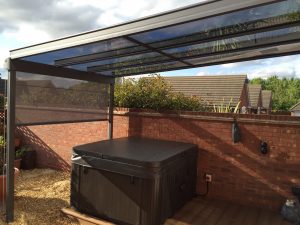 On the very coldest winter day with some sunshine however, glass rooms will be very inviting.
On the very coldest winter day with some sunshine however, glass rooms will be very inviting.
It is all about the sun and light levels, not necessarily the outside temperature.
At Samson we are told so often by customers with traditional UPVC or timber conservatories about how little they actually use their conservatories in the summer because they are too hot. They also say that the same conservatories are often too cold in the winter too.
The real point to maybe remember is that a place to sit, spend time, entertain or simply relax outside in your garden is usually going to be on a patio or terrace area, usually south, west or east facing. It is usually a place already prepared for outdoor use with garden furniture and other items such as a barbecue or deckchairs.
What ruins the lovely warmer evenings during the average year? A cool breeze as the sun goes down, or maybe it is early spring or late autumn and just that bit too cold with the light wind blowing from the North?
The solution?
Prevent the wind with a vertical fabric blind or solid glass sliding or bi folding frame-less doors.
What ruins sitting outside when it is warm but maybe not so windy? Rain or light drizzle.
The solution?
A glass roof with minimal framework for maximum light and vision.
Combine the 2 of course and you have your outdoor garden glass room, your perfect place to spend most of your time outdoors.
Most glass rooms are a ‘pent’ roof coming straight off from a supporting house wall to extend into an area that is accessible by a door or French/patio doors, but the aluminium framework of the glass room enables almost any shape to be created. The usual pent shape roof requires a wall plate at the highest point at the back of the structure and then a downwards sloping pitch is required to a front profile which is supported by aluminium posts, which also act as the rainwater downpipes with total versatility.
It is perfectly possible to have a traditional gable roof design as well as L shapes and offset projection depths. The sides can also be out of square when required to fulfill a design requirement and maybe infill a house wall coming off the main house wall.
Downpipes, chimney breasts and other brickwork can be worked around no problem and every system is designed to the millimetre and made to order, no standard sizes.
A great many people install a glass roof system into a corner of a house, or between two walls coming off the main house. This is a perfect way of protecting an outdoor area and having somewhere to enjoy in all weathers, particularly if there are two or more doors exiting the house into the area. This will help it to become another part of the house in daily use, but also outdoor covered area.
The roof or room can be almost any size, with a usual projection maximum depth of six meters for most applications with pent roof shapes. The width can be anything, odd shapes and commercial applications are not a problem as the system is modular with natural breaks in maximum lengths simply accommodated in the designs.
See just some of the shapes below:
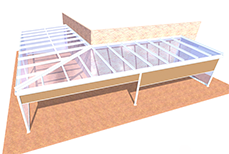
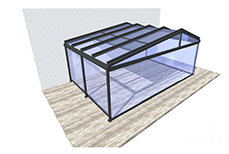
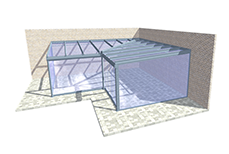
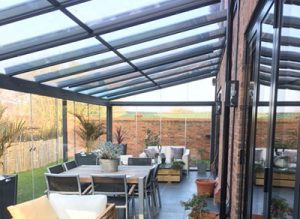 For a normal enclosed glass room or glass roof system the basic requirement is to ensure there is at least a concrete pad underneath each of the supporting front posts. There is no actual requirement for any concrete footings underneath the glass sliding door systems but they certainly cannot just sit onto a grass or earth surface, and nor would you want them too. For the bi folding doors a far more accurate and stable base is required, particularly if the tracks are to be recessed into the floor.
For a normal enclosed glass room or glass roof system the basic requirement is to ensure there is at least a concrete pad underneath each of the supporting front posts. There is no actual requirement for any concrete footings underneath the glass sliding door systems but they certainly cannot just sit onto a grass or earth surface, and nor would you want them too. For the bi folding doors a far more accurate and stable base is required, particularly if the tracks are to be recessed into the floor.
The back of a glass roof/room is an aluminium wall plate and that needs to be installed to a structurally sound and suitable wall and is always the highest part of the system so when we are asked to install to single story properties there is quite often the need to lift this wall plate up higher using steel or aluminium brackets in order to give a sufficient gradient to the roof line.
Most glass roof or room systems we install are fitted onto existing patio slabs or paving blocks, and because it is an ‘outdoor’ room it is logical to match the floor surface finish with the outside area, assuming the existing levels are satisfactory from inside to outside the house.
When we say ‘onto existing’. it is always better that the front support posts are actually sunk below the ground level into concrete whenever possible, and the existing patio slabs cut around the legs. This will provide the best long term stability and also means you can potentially change your patio surface in the future without any issues or disturbance of the support posts.
Most systems will sit directly onto the existing floor surface, and any discrepancies in the levels will be taken up with packers. The floor profile used will be cloaked inside and out to maintain a finished visual appearance between the system and the floor. This is usually sufficient to prevent all but the heaviest of rainfalls when your patio area may flood briefly with the sheer volume of water.
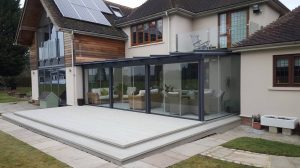 What is also desirable is a reasonable weather seal to prevent water coming inside the room, even though it isn’t a problem for the structure and materials itself. Water ingress cannot be guaranteed for these systems as there are various points at which driving rainwater could potentially enter in small amounts. Again, this is not a problem for the actual structure.
What is also desirable is a reasonable weather seal to prevent water coming inside the room, even though it isn’t a problem for the structure and materials itself. Water ingress cannot be guaranteed for these systems as there are various points at which driving rainwater could potentially enter in small amounts. Again, this is not a problem for the actual structure.
The best seal can be achieved in various ways depending on the ground surface and it is possible to cut a channel into existing slabs to then lay a steel box section support and sit the sliding door tracks onto this. This is a method used when the floor levels are considerably different, which is quite usual on any patio to direct water away from the house.
A common request is a raised area for the glass room and this can be achieved in various ways on site. A concrete raised slab or a raised decking area using floor joists is usual, and then different options for the decking finish, either timber, or the ever increasingly popular composite material decking boards, offering maintenance free surfaces and very long warranty periods from the manufacturers of these products.
The raised area is most often larger than the glass room size to create a step and plinth effect for the area and when the chosen decking is installed the bottom track for the sliding or folding doors can be made level to the floor surface rather than the standard 34mm up stand created by the bottom track of most glass doors when sitting on top of a floor.
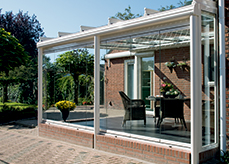
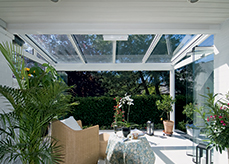
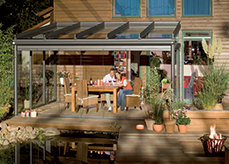
Any of our glass room systems can have either an outside or inside mounted retractable fabric roof blind on the roof to allow the control of the sunlight entering the room. South or South West facing areas should definitely have this facility to prevent the midday sun in the summer cooking the area beneath the glass roof. Although it is not necessarily any hotter than without the glass roof, the particular area has been created to sit beneath and the retractable blind enables better use of the area in the hottest summer months. These fabric blinds are always electrically operated, usually by remote control for ease of use and to allow constant adjustment as required.
External vertical fabric blinds to either the front or sides can also allow the control of low lying sun or create privacy inside the area, or can actually be used as the infill for the side or front.
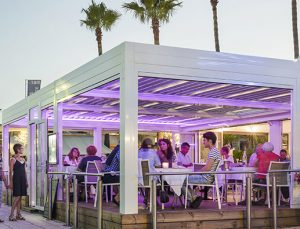 With the sliding glass doors fitted you can also have the doors open and the vertical blinds down, allowing a breeze through but blocking intense sunlight and stronger winds. Again this allows more control over the light and temperature inside and underneath the glass covered area.
With the sliding glass doors fitted you can also have the doors open and the vertical blinds down, allowing a breeze through but blocking intense sunlight and stronger winds. Again this allows more control over the light and temperature inside and underneath the glass covered area.
LED lighting is also a desirable option, either in the form of a light bar mounted to the rear of the roof and shining light down the wall or along the roof beams, or small LED lights fitted to the roof support beams underneath the glass roof. These can be on every roof beam or every other beam and again these are best remote control operated with a dimming facility to create the perfect atmosphere every time.
The LED lights are an absolute minimal power source drain at only 1.2 watts per light and with an average of about 20 – 25 lights in an average room the power required is negligible but the effect is quite superb and is not just a token gesture ambient lighting when turned up to full power.
In the cooler months some customers like to have the infra-red halogen heaters to provide sufficient heat to allow far longer use during the evening and colder, darker days. These are mounted to the front or rear of the roof system and adjusted on an angle bracket for perfect heat provision.
We have known air conditioning units to be installed in glass rooms, as well as underfloor heating and even a wood burner! All these are for providing a method of simply taking the chill off the room in colder climates just like you would inside your home, and then once up to a temperature that is comfortable the heating method can be turned off or down.
With the sliding glass door systems there are optional rubber and brush seals which can be applied to the ends of the glass sections to help reduce droughts, trap more heat in, and keep cool droughts out. These are normally clipped on in the winter months as required.
A good flow of air is desirable in any glass room to help keep potential condensation under control in the more diverse autumn and spring months with warm sunny days but cooler, damp nights.
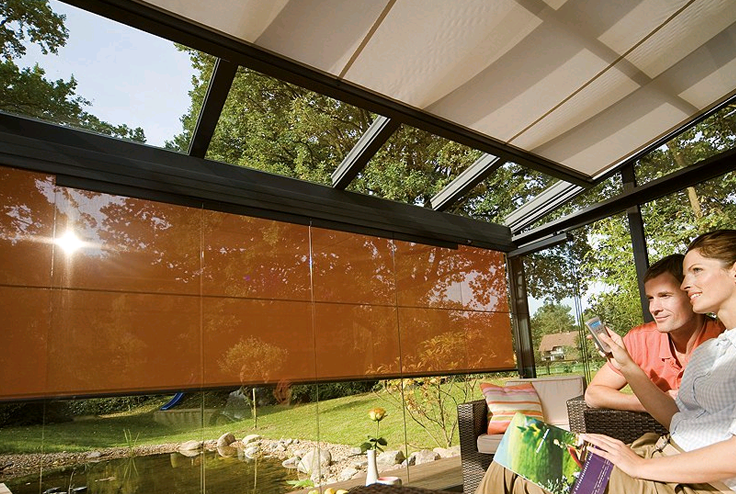


The glass roof itself will stop rainfall (and even snow) so it is only at the sides and front that there is a possibility of rain ingress, depending on the specification of the room options. The sliding glass doors work the best next to solid glass panel sections.
Be very aware from the outset there are some systems that cannot have additional side and front elements added later, so if this may be a requirement make sure this is discussed in the initial planning of your roof or room system.
Most customers tend to have a fixed glass wall or infill of sorts on the side with prevailing wind. This fixed glass can be in all glass panel sections with rubber clear seals in-between, or in an aluminium framework for a more sturdy and sealed closure. A pedestrian hinged glass door can also be offered in this type of set up for access if required.
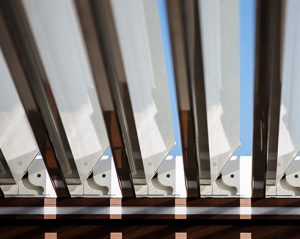 The sliding glass door options are usually completely frameless, and because they have about a 50mm overlap the driving wind and rain cannot penetrate easily. The rain may come in occasionally when the angle is just right, but again this can be stopped or reduced with different weather seals.
The sliding glass door options are usually completely frameless, and because they have about a 50mm overlap the driving wind and rain cannot penetrate easily. The rain may come in occasionally when the angle is just right, but again this can be stopped or reduced with different weather seals.
The amount of natural air flow in a glass room is also dependent on these same factors and in the summer months without the weather seals the air will certainly flow slightly more inside and this will be welcome on hotter days if you choose not to open the doors up fully.
Of course, on the hottest summer days the sides and front of your glass room can be opened up to provide just a roof cover of glass as intended, with full air flow all round. The perfect environment for all weathers.
All the rainwater from a glass room or roof is directed to the front guttering profile section to then be directed away down one or more of the legs, but can also be sent out either end and directed to other places such as water butts or nearby existing drainage areas. Even with the models supplied with an overhang of glass the rainwater is collected the same way as the glass roof will have a gap over the front profile for taking the main roof water away whilst the overhang rainwater will simply flow off the end but away from the door line. The extra glass overhang is a great option for looks but also to provide extra shelter in rain to allow the front doors to remain open and avoid splash back into the front area.
Sliding skylights are also available in many of the glass roof systems we supply and these are electrically operated for ease of operation and provide even more control of the flow of air into the room when required.
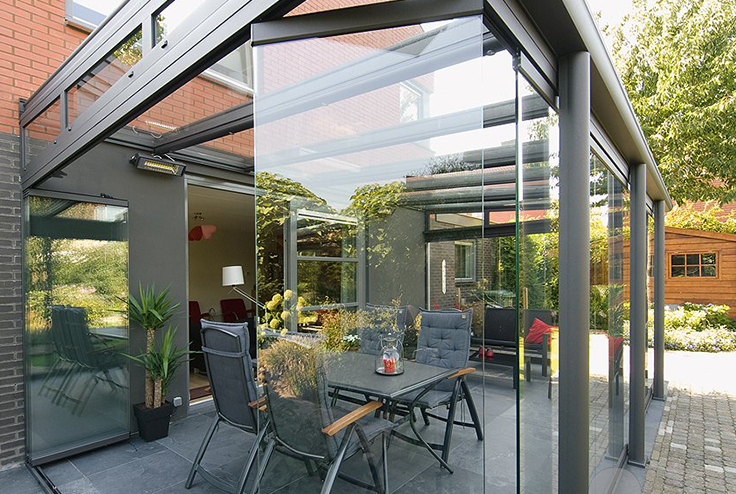
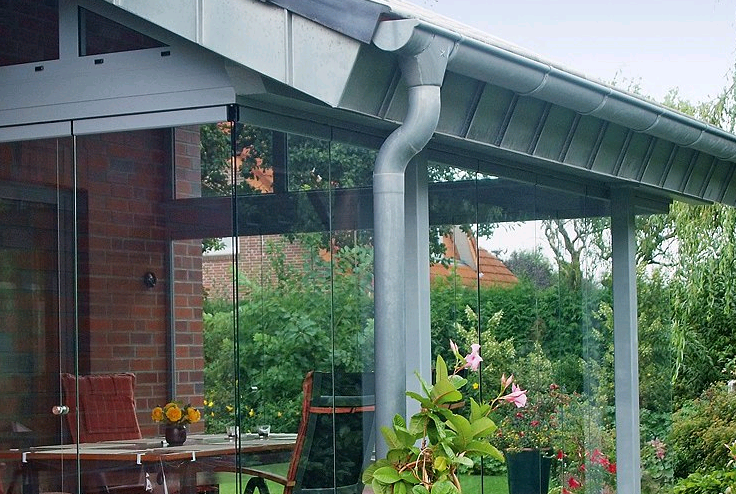

The aluminium framework is always factory finished in a high quality powder coat finish with over 50 standard colour options and some highly recommended textured finishes with metallic properties in the colour.
Finishes such as ‘Iron Glimmer’ or ‘Sparkling Iron Effect’ will look like traditional and period finishes to compliment so many properties and then there are a further 9 metallic finishes, all beautifully finished on every component including any sliding glass door tracks, to and bottom.
There are over 150 special RAL colours also to choose from if one of the standard colours does not suit your needs.
The metallic finishes on the framework are tougher and durable than the powder coated finishes, but more limited in choice.
The entire structure will be finished in your chosen colour for a perfect effect, whatever the size, and any additional elements installed will also have the same paint finish colour to their framework, including any vertical blind systems.
For any of the blinds for the sides or the roof you have over 150 different fabrics to choose from. Dark colours for south facing units where the sun needs to be blocked and light colours for just taking the harshness away from midday sun or low sun if you happen to face the west. There is a colour for everyone’s taste, solids, stripes, blocks and other more modern or diverse materials with small perforations to give some vision when used.
The fabrics are solution dyed to make them colour fast and with stay beautiful for many years to come thanks to the dirt and water repellent nano coating applied.


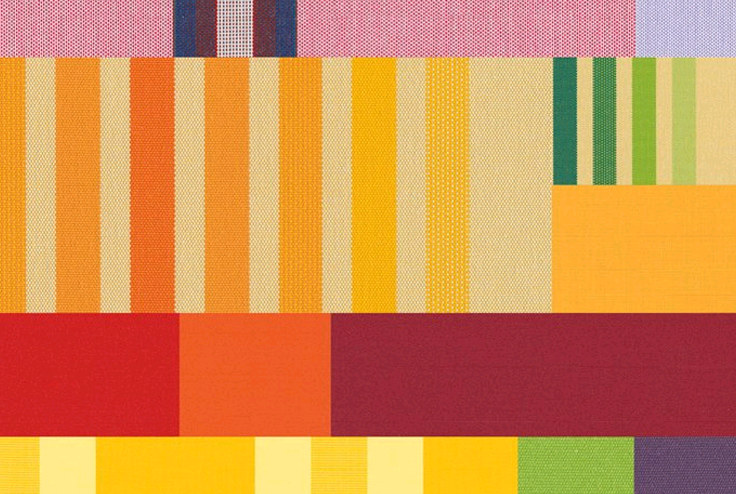
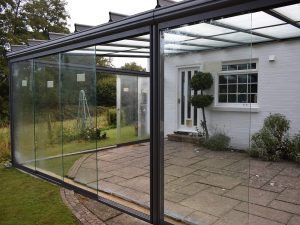 ‘Do we need planning permission?’ is a regular question when it comes to glass rooms, and we cannot ever truly answer that question fully as every local authority is different in their views. Alongside this, once you bring in listed properties, conservation areas and areas of outstanding natural beauty it gets a little more complicated. However, on a positive note, we have successfully installed many different glass rooms where the relevant local authority had no objection at all to the structure when presented with drawings and mock up images, and there were already restrictions in place in these cases for other products.
‘Do we need planning permission?’ is a regular question when it comes to glass rooms, and we cannot ever truly answer that question fully as every local authority is different in their views. Alongside this, once you bring in listed properties, conservation areas and areas of outstanding natural beauty it gets a little more complicated. However, on a positive note, we have successfully installed many different glass rooms where the relevant local authority had no objection at all to the structure when presented with drawings and mock up images, and there were already restrictions in place in these cases for other products.
The recent relaxing of laws governing the addition of conservatories on homes has helped strengthen any objection ever happening with glass rooms, as long as you stick within the percentage terms as laid out, even though as we say it is a temporary structure
The glass roof and even complete glass room is considered a ‘temporary structure’ by definition as it is not insulated, does not require traditional building foundations and cannot be considered as living space in building control terms, so is considered a temporary space.
The open and very discreet visual effect created by frameless doors mean that any building is hardly affected by the addition of a glass roof or room, the whole purpose is maximum light and vision so it is a preferred product to a conservatory or timber orangery in many cases.
We can help with any applications you may want to submit with 3D drawings and can organise a computer generated image too if you provide a good quality Jpeg page of your home and the area where you require the glass room or roof.
Various glass specification are used in our glass rooms/roof structures, usually varying from 8mm to 12mm, and always either toughened or laminated glass for safety reasons alone – ‘safety glass’
The glass is nearly always clear as this is part of the reason for having the system in the first place – maximum light and vision. South facing glass roof and room systems can be specified with coloured tinted glass if required, or a retractable roof blind to control and reduce the intensity of the sunlight during the middle of the day.
The roof sections are nearly always 10 – 10.8mm laminated glass but we do have roof systems requiring only 6mm glass as well as optional polycarbonate infill sections in 10 – 45mm sections.
Polycarbonate is far less money than glass but glass will wear better and is nowhere near as noisy in heavier rainfall sessions. Glass also gives true clear vision where polycarbonate has a clear option but being twin or triple walled the clarity of vision is lost a bit.
The sliding and folding glass door options are always constructed from 10mm toughened glass with an optional heat treatment if the glass is to be exposed to more extreme weather such as high up on a roof top, coastal locations, or similar.
Smaller glass sections, such as in the trapezium infills above the side doors will usually be 6mm toughened glass as the size used does not require thicker glass, but it can be specified if required.
Sliding glass doors are nearly always 10mm toughened and totally clear in their finish.
We do get asked about self-cleaning glass but this is not recommended in the roof sections as the glass is not vertical for a start and the treatment for self-cleaning glass can also react with the rubber weather seals used in the roof support struts.
For all static large glass infills used in glass rooms, the glass is normally 10 or 12mm and this can be whatever finish is required as the use of static glass is usually on a side where access is never required and is normally the side blocking the prevailing wind. Glass also does not have to go all the way from the top to the bottom; you can have an aluminium section in the lower half for example or have several glass sections with individual aluminium frame sections for extra stability.
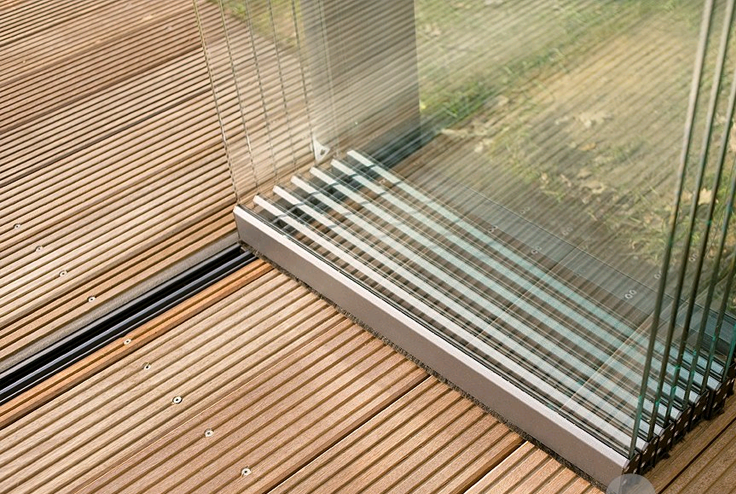
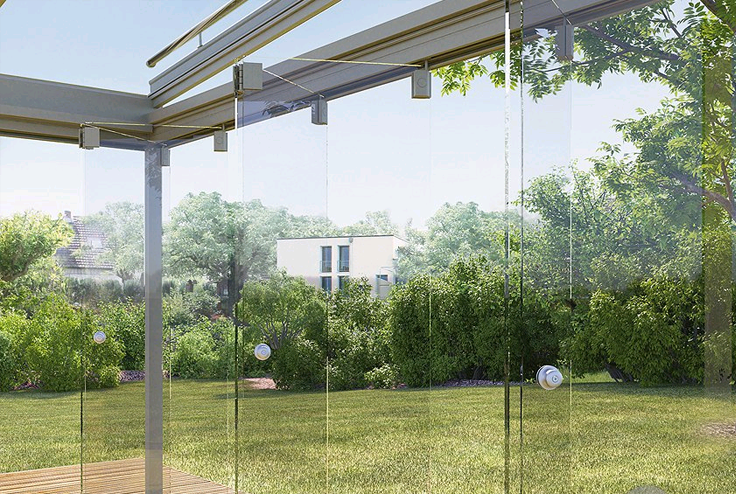
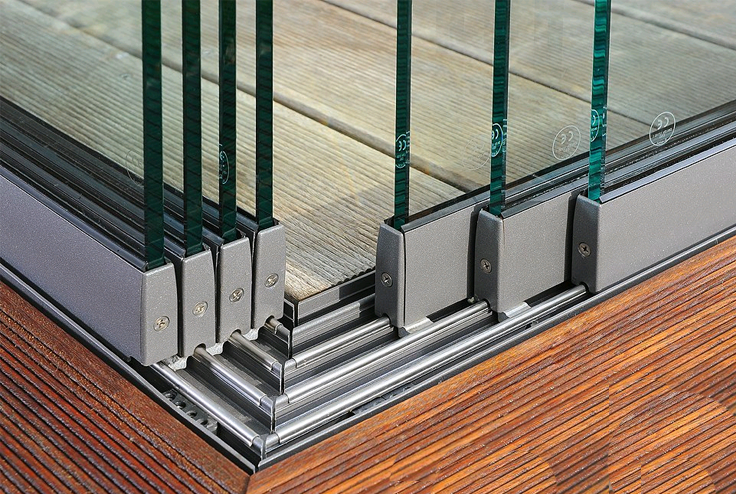
Many glass rooms are fitted directly onto an existing patio surface so the inside and outside flooring is the same. Many customers want to raise the area for the glass room and this can be done with either a concrete base or by installing a decking system sub frame and raising the room and the decking at the same time.
Some customers will maybe lay ceramic or clay tiles to the inside area of the glass room, and again this will end up usually being a higher level than the outside floor level. The tracks used in the sliding doors can be incorporated into a decking or tiled area to reduce or eliminate the raised track section altogether.
Timber flooring is ok as long as the timber species used is capable of dealing with damp or wet conditions, always bear in mind this type of room will have condensation in it at some point during the average year in the UK. Modern composite timbers will usually be best in this instance and a flooring specialist can advise on this but be sure to stress the glass room is not insulated and will probably not have a damp proof coarse underneath, which is recommended if you are creating a concrete base from scratch specifically for the project.
Some customers have installed underfloor heating systems simply to reduce the potential condensation in the more changeable months of the year, others have added small woodburners inside.
The latest ‘eco’ decking flooring systems, using very tough composite materials are becoming increasingly popular as they are maintenance free, and have a very long life span indeed, especially compared to traditional timber decking. This decking is also very good in damp or wet conditions ensuring an anti-slip surface is maintained at all times.
Many finished colours and textures are available and we use the Millboard decking, see their website for full details of their products; www.millboard.co.uk.
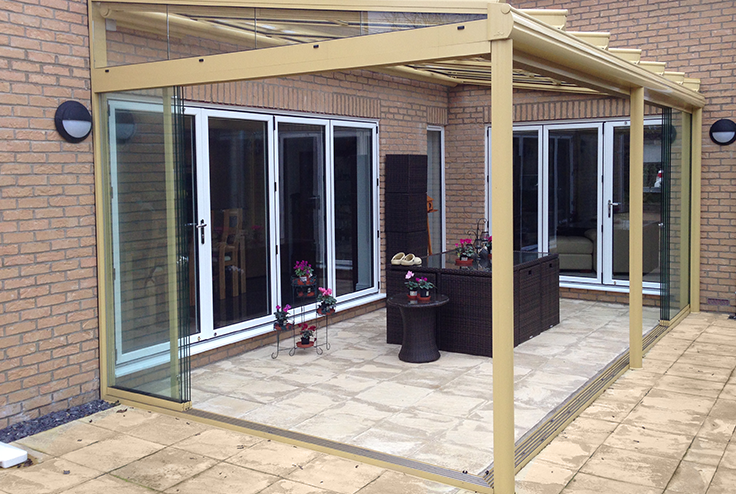
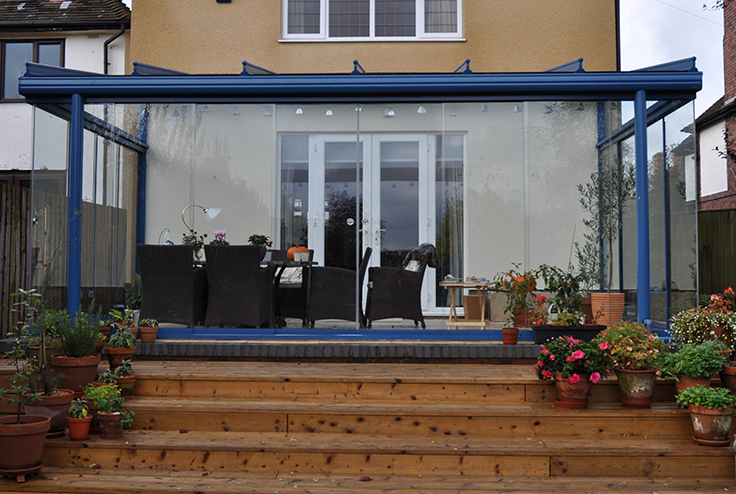

When you install a glass room framework onto a patio and use a house wall for the wall plate it is inevitable that there will be a great many areas where the levels are not true and of course for most patios there should even be a small slope away from the house wall to ensure water drainage so installing a system that needs to be completely square and true will require packers or other methods to integrate the bottom tracks into the out of level floor.
A house wall with down pipes or feature bricks protruding in the area of installation will need cutting around carefully or require the whole unit to be packed away from the wall, and all these various areas need careful finishing ensuring your glass room looks correct when finished. We do work with many customers on new build and refurbishment projects so many of these finish the infilling and trimming themselves. On timber clad or textured rendered houses for example making aluminium sections truly integrate will be reasonably challenging sometimes and different people will have different opinions on how it should be finished of course.
Careful and accurate site measuring and laser levelling will pre determine how little or how much trimming may be required as well as leading to a discussion on whether to pack up the lower levels or cut into the higher levels of the existing floor levels. When deciding on a new and possibly raised area for the glass room a lot of this trimming and finishing will not usually be required as a new level surface will be created with the installation.
Many standard mastics and sealants will not be suitable for an aluminium glass room structure, especially if the framework is in one of the metallic finishes. High grade sealants are specifically used to ensure the best and longest term results.
Samson Awnings are a family owned and operated company and are part of the Dove Group of companies, a group of companies offering the highest quality building products for domestic and commercial properties since 1986.
We are not a ‘direct sales’ company where you may find unacceptable levels of contact from a salesperson who is heavily reliant upon commission for sales made. You also want to be sure you have the right specification for your home and this sometimes can take a lot of time to go through properly.
Step 1.
Telephone, email directly, or call into our head office at Wellingborough. You can actually view and sit inside our glass rooms and glass verandas and try the doors, etc. With some basic ideas on the size required and what you expect from the system we can hopefully give you a budget price almost immediately with some options to consider too.
Step 2.
If you think the pricing is in your budget we usually like to maybe see a photograph or 2 of the area so we can verify the installation and again reaffirm our budget price.
Step 3.
A site survey. We don’t avoid surveying, but like to ensure both parties are happy about the proposals before we commit to coming to site. Once on site we can verify measurements, levels, specifications, accessories, and of course the price. Our sales person and surveyor are not commission driven so will have no interest in overcharging you at any point, just open and honest pricing on whatever product is suitable for you.
If the price is acceptable we ask for a deposit of 50% and then the process of ordering with the factory begins.
Step 4.
Once the deposit is paid we will produce a final set of drawings and a specification listing for you to sign and agree and then the system will be ordered with the factory for a delivery date normally about 4-5 weeks later, depending on the system chosen. Some simpler glass or polycarbonate roof systems can be as little as 2-3 weeks for delivery.
We book in a date with yourself as soon as we have a confirmation of delivery and the glass room may take anything from 2 – 5 days to install depending on size and specification.


 Give us a call
Give us a call Send us an email
Send us an email Get a quote
Get a quote Book a survey
Book a survey
















